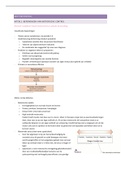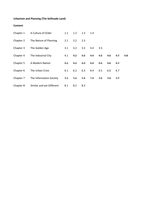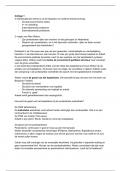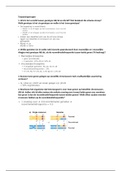Lecture 1: Concepts and the History of Development
Compulsory reading:
- Susanne Hoeber Rudolph (2005) The Imperialism of Categories. Situating
Knowledge in a Globalized World”. Perspectives on Politics 3 (1): 5-14.
- Acemoglu, Daron, Simon Johnson, and James Robinson. - “The Colonial
Origins of Comparative Development. An Empirical Investigation.” American
Economic Review, 2001.
Guiding questions:
- What is ‘development studies’ and what should it be?
- Are analytical categories such as ‘developed’ and ‘developing’, which are the
bedrock of development studies, relevant in the contemporary world?
- Should research on development involve the construction of a ‘critical perspective’?
Does it need to be ‘radicalised’?
- How do we ‘measure’ development? What are the advantages and disadvantages
of doing so?
- In what historical contexts did the modernization perspective arise and what are its
basic assumptions about development?
Today we will discuss the main concepts and the history of the idea of international
development. Exam is written, on campus (3 questions for 100 points in total). The
format will be three questions and you have to choose two questions to answer. You
can use the syllabus but also things you have seen or heard to use in your essay.
There are two optional exercises to gain extra points (5).
Week 2: Concerning violence documentary (submit essay before class!)
Week 8: Politics of extractivism in indigenous land.
You will get feedback on this and know how you can better answer on the exam. It
gives information on how to write a good essay.
After WWII, development was implemented to put countries on the way of
modernization as in the West. There are political ideas on what development is and
there are plans and policies that are created. The most important part of the politics of
development is not the discourses that are available but also the silences, what is being
concealed. This we will try to understand in this course. We will look at how
development was created as a concept. Going from colonial governmentality, how
Christianity and the civilizing mission are the president of current ideas on
,development. We will talk about the history of the modern development project. This
has been happening since WWII and the creation of the United Nations.
1. What is development?
The millennium development goals were implemented in the 2000. They were
supposed to be met by 2015 but this was not the case. The sustainable development
goals were set in 2015 by the UN. This is the framework of the idea of national
development we have at the UN. Not everybody has the same idea about development
but this is the framework that makes possible the policies and interventions that will
take place. The goals are common sense and we have a common goals. The UN thinks
that progress is a linear idea of time. You have goals to be achieved, not a process.
The concept of development understood by the UN, invokes a series of images. They
go back to the idea of modernization. Urbanisation, technological advancements, etc.
come back which were present in the 50s and 60s. Nation can develop if they follow
industrialization.
Development has been a process organized by domination. They are justified by
Christianity, civilization, etc. But there is also a lot of resistance. We will also talk about
these other ideas.
How does the World Bank understand development? It
uses GNI to divide countries in the world. There are
different categories ‘high income’, ‘upper middle income’,
lower middle income and low income. There is a belief
that with greater economic wealth, then the benefits are
coming. Even the World Bank is using also other ways to
measure development. The GNI has been used together
with the HDI. This was developed by the UN in the 80s.
The idea was to shift the focus of economic to also health
and education. They wanted to focus on the quality of life.
It still has a economic aspect but it includes other aspects
as well.
If we look at both pictures, they are quite similar (HDI
versus GNI). Is there then no real reason to use the HDI
then the GNI? By using the HDI you are also promoting
development factors not based solely on economic
growth. If you are thinking about development in a more
complex way, the policies will also be different according.
But! They do not consider inequalities in spatial terms.
When you look at the two maps, the world is divided into countries but do not consider
how people within countries live differently. Another critique is that take into account
on how people want to live their life. They take a set of ideas of what development
should be about and implement it according to those indicators.
,Oxfam has changed their idea on development. It was funded as a poverty relief
organisation. Since last year they created a Powershift Project (see link Instagram).
They are trying to portray the main ideas of development in an artistic way. Quantitative
indicators were developed in the 50s and 60s and the ideas of rationality and how the
social sciences should also be based on the natural sciences. In the middle they are
also talking about measurements but in a different way. Ranking are not realities. There
is a linear and global way of looking at development.
, UNRISD looks as development as social.
ECLAC was created for the economics of Latin America but later also implemented
social development. They wanted to counter the stages of growth. It was a way to say
that Latin America are not late comers to development but we have to take into account
the social and historic factors. You cannot simply apply a hegemonic development
project to different regions of the world. They are not late comers, it is actually
something different.
Navyanda looks at development in a very different way. It talks about how nature and
human lives cannot be separated. We can fight against poverty etc by changing to way
we relate to nature and environment.
Post-1945 is key for the development idea of the UN as they use it now.
➢ With the Marshall plan (1948) the US started rebuilding Europe.
➢ President Truman held his famous speech where underdevelopment became a
new world view (1949).
➢ Underdevelopment becomes a new worldview. There is a binary view of
underdeveloped and developed.
➢ There is a link of development in capitalism and as a way to go against
communism. If we raise the standards of living, then we show that capitalism is
the best way to go for humanity.
➢ Economic growth is equated with successful development. Industrialisation is
the engine of growth and is measured in GDP.
2. Modernisation theory (1950s-1960s)
The West was seen to show the nations of the world the future. It gained interest and
in economic terms it was about urbanisation, the use of technology and
industrialization. These are still to this day in the SDGs and are seen as common
sense. This is also reflected in the social and cultural terms. The Enlightenment period
involved this importance of rational and scientific approaches. What is problematic is
that the idea of development was developed in a certain time and space and has been
spread throughout the world. For some it is linked to the destruction of cultures,
enclosures, etc. It is being interpreted wrong.
This paradigm became hegemonic and has influenced the way in how societies were
studied and compared. Modern societies were compared to traditional societies and
the modern societies represented progress. Development portrayed a transition from
traditional to modern. This modernity was something to desire and was supposed to
be achieved by copying the characteristics of the evolution of Western societies.
The five stages of Rostow was proposed in his book and the subtitle was to go against
communism. Nation states could pass from traditional societies to high consumption
societies. The theory died out in the 60s but made a comeback in the 80s, both in
academic circles as in politics. There was the idea that there was no alternative to
Western development. In the 80s it Is not about these 5 stages but about good
governance.











